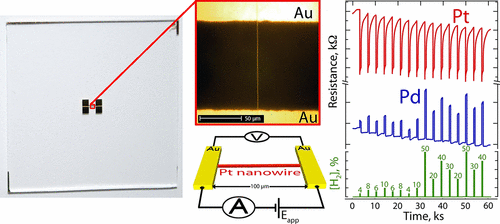当前位置:
X-MOL 学术
›
Acc. Chem. Res.
›
论文详情
Our official English website, www.x-mol.net, welcomes your
feedback! (Note: you will need to create a separate account there.)
A Nose for Hydrogen Gas: Fast, Sensitive H2 Sensors Using Electrodeposited Nanomaterials
Accounts of Chemical Research ( IF 16.4 ) Pub Date : 2017-08-04 00:00:00 , DOI: 10.1021/acs.accounts.7b00163 Reginald M. Penner 1
Accounts of Chemical Research ( IF 16.4 ) Pub Date : 2017-08-04 00:00:00 , DOI: 10.1021/acs.accounts.7b00163 Reginald M. Penner 1
Affiliation

|
Hydrogen gas (H2) is odorless and flammable at concentrations above 4% (v/v) in air. Sensors capable of detecting it rapidly at lower concentrations are needed to “sniff” for leaked H2 wherever it is used. Electrical H2 sensors are attractive because of their simplicity and low cost: Such sensors consist of a metal (usually palladium, Pd) resistor. Exposure to H2 causes a resistance increase, as Pd metal is converted into more resistive palladium hydride (PdHx). Sensors based upon Pd alloy films, developed in the early 1990s, were both too slow and too insensitive to meet the requirements of H2 safety sensing.
中文翻译:

氢气的鼻子:使用电沉积纳米材料的快速灵敏H 2传感器
氢气(H 2)在空气中的浓度超过4%(v / v)时是无味且可燃的。无论在何处使用H 2,都需要能够以较低浓度快速检测到它的传感器来“嗅探”泄漏的H 2。电气H 2传感器因其简单性和低成本而吸引人:此类传感器由金属(通常为钯,Pd)电阻器组成。暴露于H 2会导致电阻增加,因为Pd金属会转化为电阻更大的氢化钯(PdH x)。1990年代初开发的基于Pd合金膜的传感器太慢且太不灵敏,无法满足H 2安全感测的要求。
更新日期:2017-08-04
中文翻译:

氢气的鼻子:使用电沉积纳米材料的快速灵敏H 2传感器
氢气(H 2)在空气中的浓度超过4%(v / v)时是无味且可燃的。无论在何处使用H 2,都需要能够以较低浓度快速检测到它的传感器来“嗅探”泄漏的H 2。电气H 2传感器因其简单性和低成本而吸引人:此类传感器由金属(通常为钯,Pd)电阻器组成。暴露于H 2会导致电阻增加,因为Pd金属会转化为电阻更大的氢化钯(PdH x)。1990年代初开发的基于Pd合金膜的传感器太慢且太不灵敏,无法满足H 2安全感测的要求。











































 京公网安备 11010802027423号
京公网安备 11010802027423号